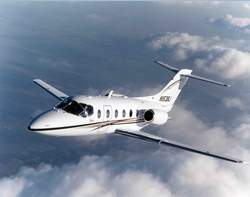Tue, Mar 12, 2013
Problems Have Been Noted With Horizontal Stab De-Icing Equipment
The FAA has issued a Special Airworthiness Information Bulletin (SAIB) after learning of a problem with the horizontal stabilizer de-icing system on some Hawker 400 aircraft. The bulletin was sent to owners and operators of Hawker Beechcraft Corporation (Type Certificate Previously Held by Raytheon Aircraft Company) Model Hawker 400 airplanes having serial numbers (SNs) RJ-1 through RJ-65 inclusive; Model Hawker 400A airplanes having S/Ns RK-1 through RK-353 inclusive, and S/Ns RK-354 through RK-379 inclusive; and Model Hawker 400T airplanes having S/Ns TX-1 through TX 13 inclusive, of an airworthiness concern regarding Metal Oxide Semiconductor Field Effect Transistor (MOSFET) contactors for the horizontal stabilizer de-ice system.

The FAA says it received notification of a field report of a horizontal stabilizer de-ice system equipped with a MOSFET contactor, which was inoperative when an internal short occurred in the MOSFET contactor causing it to overheat. The “H STAB ICE FAIL” annunciation for horizontal stabilizer de-ice failure was provided to the flight crew. A post-flight inspection revealed heat damage to the MOSFET contactor and its associated elevator heater horn.
Hawker Beechcraft Corporation issued Recommended Service Bulletin SB 30-4073, dated August 2011, to provide operators with guidelines for inspecting to determine if certain MOSFET contactors are installed on the horizontal stabilizer de-ice system. Hawker Beechcraft Corporation also issued Kit 128-3065 to provide operators with guidelines for installation of replacement contactors.
A preflight procedure also exists to verify proper system function, which limits exposure. In addition, the airplane flight manual has emergency procedures, which accounts for the “H STAB ICE FAIL” annunciation for a horizontal stabilizer de-ice failure. The specified actions include these procedures for the pilot to follow to avoid the icing environment.
The FAA recommends that all owners and operators of the subject airplanes comply with the guidelines outlined in Hawker Beechcraft Recommended Service Bulletin SB 30-4073, dated August 2011, and Kit 128-3065, dated August 2011. At this time, the agency says the airworthiness concern is not considered an unsafe condition that would warrant airworthiness directive (AD) action.
More News
He Attempted To Restart The Engine Three Times. On The Third Restart Attempt, He Noticed That Flames Were Coming Out From The Right Wing Near The Fuel Cap Analysis: The pilot repor>[...]
Make Sure You NEVER Miss A New Story From Aero-News Network Do you ever feel like you never see posts from a certain person or page on Facebook or Instagram? Here’s how you c>[...]
From 2009 (YouTube Edition): Leading Air Show Performers Give Their Best Advice for Newcomers On December 6th through December 9th, the Paris Las Vegas Hotel hosted over 1,500 air >[...]
Aero Linx: NASA ASRS ASRS captures confidential reports, analyzes the resulting aviation safety data, and disseminates vital information to the aviation community. The ASRS is an i>[...]
“For our inaugural Pylon Racing Seminar in Roswell, we were thrilled to certify 60 pilots across our six closed-course pylon race classes. Not only did this year’s PRS >[...]
 NTSB Final Report: Rutan Long-EZ
NTSB Final Report: Rutan Long-EZ ANN FAQ: Turn On Post Notifications
ANN FAQ: Turn On Post Notifications Classic Aero-TV: ICAS Perspectives - Advice for New Air Show Performers
Classic Aero-TV: ICAS Perspectives - Advice for New Air Show Performers ANN's Daily Aero-Linx (06.28.25)
ANN's Daily Aero-Linx (06.28.25) Aero-News: Quote of the Day (06.28.25)
Aero-News: Quote of the Day (06.28.25)



